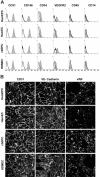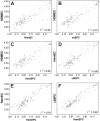Endothelial progenitor cells from infantile hemangioma and umbilical cord blood display unique cellular responses to endostatin
- PMID: 16861344
- PMCID: PMC1895853
- DOI: 10.1182/blood-2006-03-006478
Endothelial progenitor cells from infantile hemangioma and umbilical cord blood display unique cellular responses to endostatin
Abstract
Infantile hemangiomas are composed of endothelial cells (ECs), endothelial progenitor cells (EPCs), as well as perivascular and hematopoietic cells. Our hypothesis is that hemangioma-derived EPCs (HemEPCs) differentiate into the mature ECs that comprise the major compartment of the tumor. To test this, we isolated EPCs (CD133(+)/Ulex europeus- I(+)) and mature ECs (CD133(-)/Ulex europeus-I(+)) from proliferating hemangiomas and used a previously described property of hemangioma-derived ECs (HemECs), enhanced migratory activity in response to the angiogenesis inhibitor endostatin, to determine if HemEPCs share this abnormal behavior. Umbilical cord blood-derived EPCs (cbEPCs) were analyzed in parallel as a normal control. Our results show that HemEPCs, HemECs, and cbEPCs exhibit increased adhesion, migration, and proliferation in response to endostatin. This angiogenic response to endostatin was consistently expressed by HemEPCs over several weeks in culture, whereas HemECs and cbEPCs shifted toward the mature endothelial response to endostatin. Similar mRNA-expression patterns among HemEPCs, HemECs, and cbEPCs, revealed by microarray analyses, provided further indication of an EPC phenotype. This is the first demonstration that human EPCs, isolated from blood or from a proliferating hemangioma, are stimulated by an angiogenesis inhibitor. These findings suggest that EPCs respond differently from mature ECs when exposed to angiogenic or antiangiogenic signals.
Figures





Similar articles
-
A switch in Notch gene expression parallels stem cell to endothelial transition in infantile hemangioma.Angiogenesis. 2010 Mar;13(1):15-23. doi: 10.1007/s10456-009-9161-5. Epub 2010 Jan 13. Angiogenesis. 2010. PMID: 20069356 Free PMC article.
-
Immunological and ultrastructural characterization of endothelial cell cultures differentiated from human cord blood derived endothelial progenitor cells.Histochem Cell Biol. 2006 Dec;126(6):649-64. doi: 10.1007/s00418-006-0201-6. Epub 2006 Jun 10. Histochem Cell Biol. 2006. PMID: 16767408
-
Tumor angiogenesis promoted by ex vivo differentiated endothelial progenitor cells is effectively inhibited by an angiogenesis inhibitor, TK1-2.Cancer Res. 2007 May 15;67(10):4851-9. doi: 10.1158/0008-5472.CAN-06-2979. Cancer Res. 2007. PMID: 17510415
-
Hemangioma Endothelial Cells and Hemangioma Stem Cells in Infantile Hemangioma.Ann Plast Surg. 2022 Feb 1;88(2):244-249. doi: 10.1097/SAP.0000000000002835. Ann Plast Surg. 2022. PMID: 35023872 Review.
-
The involvement of endothelial progenitor cells in tumor angiogenesis.J Cell Mol Med. 2004 Jul-Sep;8(3):294-300. doi: 10.1111/j.1582-4934.2004.tb00319.x. J Cell Mol Med. 2004. PMID: 15491505 Free PMC article. Review.
Cited by
-
Urinary matrix metalloproteinases-2/9 in healthy infants and haemangioma patients prior to and during propranolol therapy.Eur J Pediatr. 2012 Jun;171(6):941-6. doi: 10.1007/s00431-011-1660-x. Epub 2011 Dec 28. Eur J Pediatr. 2012. PMID: 22203431 Clinical Trial.
-
Unique responses of stem cell-derived vascular endothelial and mesenchymal cells to high levels of glucose.PLoS One. 2012;7(6):e38752. doi: 10.1371/journal.pone.0038752. Epub 2012 Jun 6. PLoS One. 2012. PMID: 22701703 Free PMC article.
-
Modulation of LIN28B/Let-7 Signaling by Propranolol Contributes to Infantile Hemangioma Involution.Arterioscler Thromb Vasc Biol. 2018 Jun;38(6):1321-1332. doi: 10.1161/ATVBAHA.118.310908. Epub 2018 May 3. Arterioscler Thromb Vasc Biol. 2018. PMID: 29724816 Free PMC article.
-
Progenitor cells in infantile hemangioma.J Craniofac Surg. 2009 Mar;20 Suppl 1(Suppl 1):695-7. doi: 10.1097/SCS.0b013e318193d6ac. J Craniofac Surg. 2009. PMID: 19169153 Free PMC article. Review.
-
Multipotential stem cells recapitulate human infantile hemangioma in immunodeficient mice.J Clin Invest. 2008 Jul;118(7):2592-9. doi: 10.1172/JCI33493. J Clin Invest. 2008. PMID: 18535669 Free PMC article.
References
-
- Mulliken JB, Glowacki J. Hemangiomas and vascular malformations in infants and children: a classification based on endothelial characteristics. Plast Reconstr Surg. 1982;69: 412-422. - PubMed
-
- Bielenberg DR, McCarty MF, Bucana CD, et al. Expression of interferon-beta is associated with growth arrest of murine and human epidermal cells. J Invest Dermatol. 1999;112: 802-809. - PubMed
-
- Mulliken JB, Fishman SJ, Burrows PE. Vascular anomalies. Curr Probl Surg. 2000;37: 517-584. - PubMed
Publication types
MeSH terms
Substances
Grants and funding
LinkOut - more resources
Full Text Sources
Other Literature Sources
Medical
Research Materials

